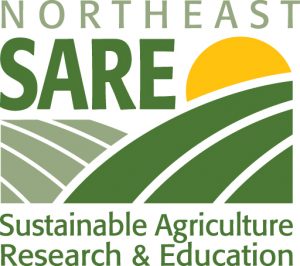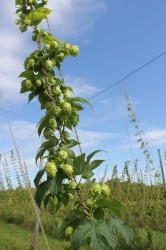Sustainable Hop Production
By implementing drip irrigation and mulching, a Maine hops farm significantly improves yields and net revenue.
SARE GRANT FNE11-711
Written by Erin Roche, UMaine Graduate Student
Located in the heart of Maine’s potato production
To the passerby, the hops trellis rising from the ground at Krista Delahunty and Jason Johnston’s farm triggers a second  glance if not a close inspection. Tucked within a county of potato fields, Aroostook Hops LLC is an island of uniqueness, welcoming back the production of hops to the Northeast. Hops, a climbing herbaceous perennial, was once commonplace in the Northeast until the 1800’s. Due to high humidity of the East, hops production largely migrated west where arid conditions limit the spread of pests and disease. Flash forward 200 years and with a growing interest in local microbreweries, hops production has returned east. As scientists and avid gardeners, Krista and Jason’s interest in producing hops began with their own homebrew. When they searched for hop rhizomes (rootstock) to plant in 2008, they found them expensive and difficult to find. Noting this surge in demand and counting thirty microbreweries in Maine alone, the couple felt that local, organic hops would be a promising enterprise.
glance if not a close inspection. Tucked within a county of potato fields, Aroostook Hops LLC is an island of uniqueness, welcoming back the production of hops to the Northeast. Hops, a climbing herbaceous perennial, was once commonplace in the Northeast until the 1800’s. Due to high humidity of the East, hops production largely migrated west where arid conditions limit the spread of pests and disease. Flash forward 200 years and with a growing interest in local microbreweries, hops production has returned east. As scientists and avid gardeners, Krista and Jason’s interest in producing hops began with their own homebrew. When they searched for hop rhizomes (rootstock) to plant in 2008, they found them expensive and difficult to find. Noting this surge in demand and counting thirty microbreweries in Maine alone, the couple felt that local, organic hops would be a promising enterprise.
Krista and Jason started with a few plants in 2008 and now have over 600 plants on 1 acre. They currently sell to Maine and New Hampshire brewers. In scaling up, the couple realized a “scientific approach” to increasing production and net revenue was necessary. Krista and Jason presupposed drip irrigation might result in greater yields based on the success large-scale Pacific Northwest growers have with irrigation. They also were curious about the effect “green manures”, or cover crops, might have on hop yield and soil nutrient levels. Krista and Jason stumbled across the Northeast SARE Farmer grant program online and decided to apply for a one-year grant. SARE requires all grantees to identify a technical advisor throughout the duration of the grant process. Krista and Jason sought out Dr. Steve Johnston for his expertise as a Crops Specialist with University of Maine Cooperative Extension and his prior experience with hops.
The SARE Project
Aroostook Hops was awarded a one-year grant of $10,197 from Northeast SARE, which covered labor, irrigation, mulch and soil sampling costs. Beginning in the fall of 2010, Krista and Jason experimented on their 1-acre hopyard, containing four varieties of hops of three planting ages (1, 2 and 3-year old plants). The couple devised a two-factor experiment to test the following questions.
- Are the costs of drip irrigation outweighed by an increase in yield and net revenue?
Krista and Jason installed drip irrigation on every other hop row and irrigated 3-4 hours every two to three days without a soaking precipitation.
- Do cover crops and mulches increase yield and net revenue?
In alternating rows, they spread straw between plants or planted summer alfalfa around the plants. The trial was designed so that every hop age experienced both cover type with irrigation, as well as cover type without irrigation. Summer alfalfa was selected because it suppresses weeds, fixes nitrogen and generally dies over the winter.
Throughout the growing season, Krista and Jason recorded supply costs, labor hours, and hop cone yield so they could evaluate the cost effectiveness of each treatment. They also took soil samples at the end of the growing season.
The Results
The research ended in the autumn of 2011, and the findings were clear — yields in the irrigated treatments were higher than the non-irrigated treatments and increased revenue more than compensated for the costs of irrigation installment and operation (Table 1). Krista and Jason analyzed the economic returns per acre for each treatment by subtracting treatment costs (material costs and labor at $15/hour) from estimated gross returns (calculated using the 2011 U.S.D.A. National Agriculture Statistics Service average price for hops of $2.77/lb). Of all of the treatments, irrigated rows with straw provided the highest revenue gain per acre. Based on soil sample results, alfalfa produced an increase in soil nitrate while soil test phosphorus and magnesium levels were higher in straw plots (data not shown). The alfalfa treatment produced an increase in yield in the non-irrigated plots. It is unclear why this same increase wasn’t observed in the irrigated plots.
Table 1: Treatment Costs and Returns
| Non-Irrigated | Irrigated | ||||
|---|---|---|---|---|---|
| Straw | Alfalfa | Straw | Alfalfa | ||
| Dry Yield (kg/acre) | 145 | 217 | 440 | 269 | |
| Gross Returns ($/acre) | $886 | $1,323 | $2,689 | $1,639 | |
| Treatment Costs ($/acre) | |||||
| Irrigation & labor | $0 | $0 | $193 | $193 | |
| Straw, materials and labor | $296 | $0 | $296 | $10 | |
| Alfalfa, materials and labor | $0 | $355 | $0 | $355 | |
| TOTAL treatment cost | $296 | $355 | $489 | $558 | |
| Net Returns* ($/acre) | $590 | $968 | $2,200 | $1,081 | |
* Net Returns = gross returns – total costs.
Data courtesy of Krista Delahunty and Jason Johnston
Summary
This positive SARE experience encouraged Krista and Jason to apply for another SARE grant focusing on methods of establishing and maintaining a weed-free hopyard. Overall, Krista and Jason found the budget sufficiently covered all grant expenses.
Krista and Jason continue to use drip irrigation with straw cover across the entire farm, and this spring, they broke ground on a 2.75-acre addition to their original hopyard.
Hops photo courtesy of Leslie and Jim Michael.
Information about the NE-SARE Farmer Grant program can be found on the NE-SARE website.
